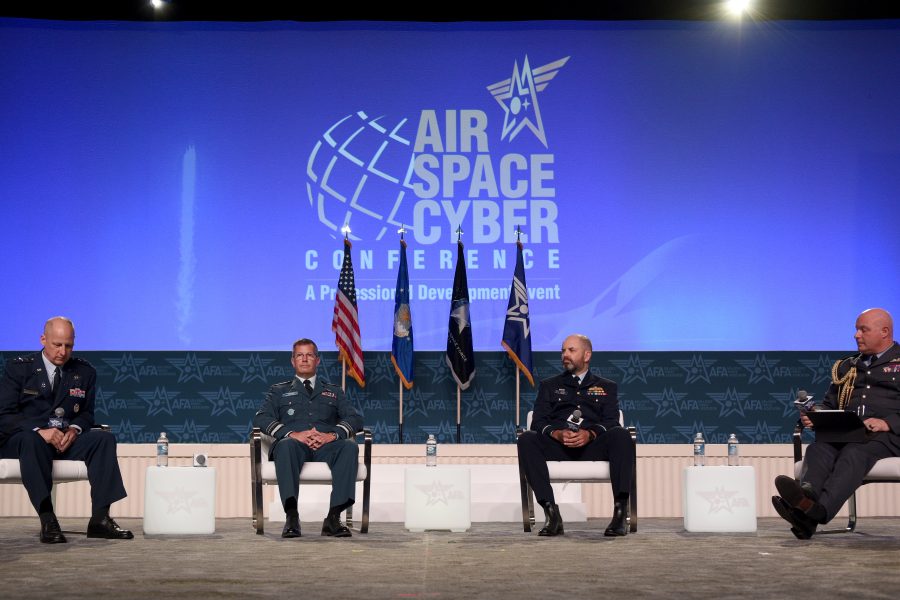The creation of the U.S. Space Force in 2019 helped spark a wave of new military space organizations around the globe and opened the door to more collaboration and discussion with allies, leaders said Sept. 11 at AFA’s Air, Space & Cyber Conference.
Hurdles remain, though, from classification to the development of new programs that involve international partners—with one top official pointing to the F-35 program, which included nine international partners in development, as a potential model.
“I think what’s unique here is, because it’s relatively new, at least as a domain, we have an opportunity to take those decades of experience and try to build something completely different,” Lt. Gen. Eric Kenny, commander of the Royal Canadian Air Force, said in a panel discussion. “In other words, something that’s allied by design, right from the get-go that is integrated, at least amongst the key partners.”
For decades, said Space Systems Command boss Lt. Gen. Michael Guetlein, the U.S. was the preeminent power in space but did not share much information on the domain with its allies.
“Everything was too highly classified to have a conversation about,” Guetlein said. “We knew about the threat and we couldn’t talk about the threat because it was too highly classified and we kept all that information to ourselves. As a result, we never really built the partnerships that we should have been building from day one to get after this. We weren’t exercising together. We weren’t doing war games together. We didn’t have common [tactics, techniques, and procedures].”
The Space Force has changed that, Guetlein said, as has the stand-up of organizations like RCAF’s 3 Canadian Space Division, U.K. Space Command, and Australia’s Defence Space Command. Now, leaders are talking like never before, but classification remains a “huge challenge.” Even so, compared to years’ past, Guetlein and other leaders agreed there has been some progress.
“When we start talking about allied by design, that’s really where we’re making the most traction, because even if I can’t talk to them about a system that I have in development, we’re getting at it behind the scenes through allied by design,” said Guetlein, pointing to the importance of standards for data and interfaces.
Beyond interoperability, the next step is for the allies to work together to develop and field a common system, suggested Royal Air Force air and space commander Air Marshal Harvey Smyth—not simply wait for the U.S. to produce and then export it through the usual Foreign Military Sales process.
“I think that idea of a properly collaborative and cooperative program of capability development, we just don’t see that in space,” Smyth said. “We’ve not got there yet. With that normally is more of ‘well, we’ve got these things, would you like to buy some,’ and then it’s, you get what you buy, and it comes off the shelf under certain restrictions.
“I think it would be really rather interesting if we were bold enough to choose a capability set that we’re all interested in, and then we look at what could an F-35-type model be? A collaborative model of capability development, where we all bring money, we all bring requirements, we look for at least some compromise, but we look for an 80 to 90 percent solution that meets everyone and we take it forward together collaboratively. That would be really interesting.”
The U.K., Canada, and Australia were all partners in the F-35 program and are participants in the Combined Space Operations Center, which has been the springboard for discussions about collaborative programs through a “capability and architectures working group,” Smyth said.
Thus far, that working group has held discussions but not made progress on picking any capabilities to work on, Smyth said.
Guetlein, for his part, predicted one area ripe to “explode,” either with FMS or collaboration between partner nations.
“We all need to know what’s going on in up in space, what we call space domain awareness or battlespace awareness,” Guetlein said. “And there’s just not enough data to go around out there. So we’ve got to share that data back and forth to get a common operating picture with our allies. And we can’t buy enough data just as the U.S. alone. We’re going to have to go into it with our partners.”
Those partners are also eager to develop capabilities of their own that they can share.
“Australia has built one of the best small-to-medium air forces in the world off the back of FMS sales, off of cooperative programs, with some exceptions like the E-7 Wedgetail, which we’ve done largely on our own. But it’s also demonstrated our ability to play in that space and to add value. So that’s our history with the Air Force,” said Air Commodore Angus Porter, air and space attaché for the Australian Embassy. “And our future in the space domain, we see as a mix of those of those three: FMS sales, cooperative program, and also some aspects that we will do on our own.”
“One of our projects that we have is a polar SATCOM, narrowband/wideband SATCOM, that we’re looking to have up in the early part of 2030s as one of our big projects that we’re putting forward,” added Kenney. “I think that provides a SATCOM capability from [the 65th to the 90th North parellels] in the Arctic, which we don’t currently have, which will allow us to better share information with all those that fly up there, whether that be on the North American side or on the European side with NATO, as well.”

